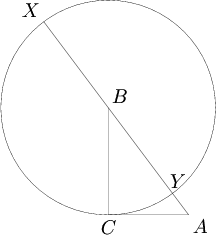Pythagorean Theorem
The Pythagorean Theorem states that for a right triangle with legs of length ![]() and
and ![]() and hypotenuse of length
and hypotenuse of length ![]() we have the relationship
we have the relationship ![]() . This theorem has been known since antiquity and is a classic to prove; hundreds of proofs have been published and many can be demonstrated entirely visually. The Pythagorean Theorem is one of the most frequently used theorems in geometry, and is one of the many tools in a good geometer's arsenal. A very large number of geometry problems can be solved by building right triangles and applying the Pythagorean Theorem.
. This theorem has been known since antiquity and is a classic to prove; hundreds of proofs have been published and many can be demonstrated entirely visually. The Pythagorean Theorem is one of the most frequently used theorems in geometry, and is one of the many tools in a good geometer's arsenal. A very large number of geometry problems can be solved by building right triangles and applying the Pythagorean Theorem.
This is generalized by the Pythagorean Inequality and the Law of Cosines.
Contents
[hide]Proofs
In these proofs, we will let ![]() be any right triangle with a right angle at
be any right triangle with a right angle at ![]() , and we use
, and we use ![]() to denote the area of triangle
to denote the area of triangle ![]() .
.
Proof 1
Let ![]() be the foot of the altitude from
be the foot of the altitude from ![]() .
. ![]() ,
, ![]() ,
, ![]() are similar triangles, so
are similar triangles, so ![]() and
and ![]() . Adding these equations gives us
. Adding these equations gives us ![]()
Proof 2
Let ![]() be the foot of the altitude from
be the foot of the altitude from ![]() .
.
![[asy] pair A, B, C, H; A = (0, 0); B = (4, 3); C = (4, 0); H = foot(C, A, B); draw(A--B--C--cycle); draw(C--H); draw(rightanglemark(A, C, B)); draw(rightanglemark(C, H, B)); label("$A$", A, SSW); label("$B$", B, ENE); label("$C$", C, SE); label("$H$", H, NNW); [/asy]](http://latex.artofproblemsolving.com/a/1/9/a19bed9f5ac971139756a395da4e29366d45fc52.png)
Since ![]() ,
, ![]() ,
, ![]() are similar right triangles, and the areas of similar triangles are proportional to the squares of corresponding side lengths,
are similar right triangles, and the areas of similar triangles are proportional to the squares of corresponding side lengths,
![]() But since triangle
But since triangle ![]() is composed of triangles
is composed of triangles ![]() and
and ![]() ,
, ![]() , so
, so ![]() . ∎
. ∎
Proof 3
Consider a circle ![]() with center
with center ![]() and radius
and radius ![]() . Since
. Since ![]() and
and ![]() are perpendicular,
are perpendicular, ![]() is tangent to
is tangent to ![]() . Let the line
. Let the line ![]() meet
meet ![]() at
at ![]() and
and ![]() , as shown in the diagram:
, as shown in the diagram:

Evidently, ![]() and
and ![]() . By considering the Power of a Point
. By considering the Power of a Point ![]() with respect to
with respect to ![]() , we see
, we see
![]() ∎
∎
Proof 4
![]() and
and ![]() are squares.
are squares.
![[asy] pair A,B,C,D; A = (-10,10); B = (10,10); C = (10,-10); D = (-10,-10); pair E,F,G,H; E = (7,10); F = (10, -7); G = (-7, -10); H = (-10, 7); draw(A--B--C--D--cycle); label("$A$", A, NNW); label("$B$", B, ENE); label("$C$", C, ESE); label("$D$", D, SSW); draw(E--F--G--H--cycle); label("$E$", E, N); label("$F$", F,SE); label("$G$", G, S); label("$H$", H, W); label("a", A--B,N); label("a", B--F,SE); label("a", C--G,S); label("a", H--D,W); label("b", E--B,N); label("b", F--C,SE); label("b", G--D,S); label("b", A--H,W); label("c", E--H,NW); label("c", E--F); label("c", F--G,SE); label("c", G--H,SW); [/asy]](http://latex.artofproblemsolving.com/4/1/a/41a647e5a19503aef099a12685b97760238aaa77.png)
![]() . ∎
. ∎
Pythagorean Triples
- Main article: Pythagorean triple
A Pythagorean triple is a triple of positive integers such that ![]() . All such triples contain numbers which are side lengths of the sides of a right triangle. Among these, the Primitive Pythagorean triples, are those in which the three numbers are coprime. A few of them are:
. All such triples contain numbers which are side lengths of the sides of a right triangle. Among these, the Primitive Pythagorean triples, are those in which the three numbers are coprime. A few of them are:
![]()
![]()
![]()
![]()
![]()
![]()
![]()
![]()
Note that (3,4,5) is the only Pythagorean triple that consists of consecutive integers.
Any triple created by multiplying all three numbers in a Pythagorean triple by a positive integer is Pythagorean. In other words, if (a,b,c) is a Pythagorean triple it follows that (ka,kb,kc) will also form a Pythagorean triple for any positive integer constant k.
For example,
![]()
![]()
![]()
Problems
Introductory
Problem 1
Right triangle ![]() has legs of length
has legs of length ![]() and
and ![]() . Find the hypotenuse of
. Find the hypotenuse of ![]() .
.
Solution 1 (Bash)
![]() .
.
Solution 2 (Using 3-4-5)
![]() is the resulting Pythagorean triple when
is the resulting Pythagorean triple when ![]() is multiplied by
is multiplied by ![]() , so the answer is
, so the answer is ![]() .
.
Problem 2
Right triangle ![]() has side lengths of
has side lengths of ![]() and
and ![]() . Find the sum of all the possible hypotenuses.
. Find the sum of all the possible hypotenuses.
Solution (Casework)
Case 1:
3 and 4 are the legs. Then 5 is the hypotenuse.
Case 2:
3 is a leg and 4 is the hypotenuse.
There are no more cases as the hypotenuse has to be greater than the leg, so the sum is ![]() .
.









